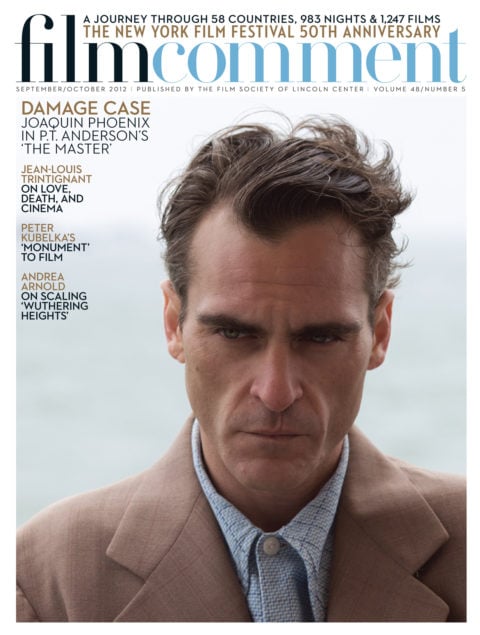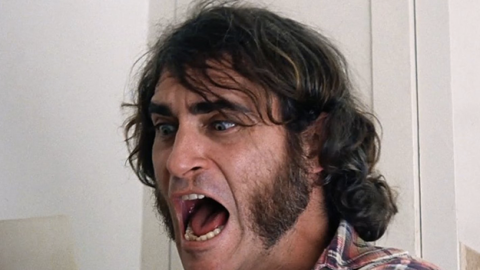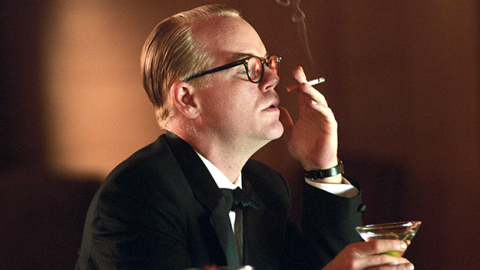

In The Master, the American past of the late Forties and early Fifties is a very, very foreign country, rendered doubly strange from the perspective of the early 21st century and its nervous obsession with right now. Who are these people? Who is this grandiose, folksy, impetuous, self-appointed sage named Lancaster Dodd (Philip Seymour Hoffman)? Who are these wealthy people who subsidize him, invite him into their homes and onto their yachts, and listen to him with such rapt attention? And why is Dodd watching so closely over a busted wreck like Freddie Quell (Joaquin Phoenix)?
One could say that they’re listening to Dodd because he’s really L. Ron Hubbard, and that Dodd is paying attention to the fictional Quell because Hubbard was a charlatan whose story requires a dramatic dupe. That’s an unsatisfactory answer, of course, but it points to what I am sure will be a common complaint about this grandly scaled and rewardingly knotty movie. By now, everyone knows that Dodd is Hubbard; that The Cause, his religion-in-the-making, is Dianetics, soon to develop into Scientology; that Dodd’s book Split Saber is Hubbard’s book Excalibur; that the character of Helen (played by Laura Dern) is a composite of various early Hubbard financiers like Jack Parsons and Don Purcell (she has presumably been named after early Scientology stalwart Helen O’Brien); that P.T. Anderson was a close friend of Jeremy Blake, who drowned himself following the suicide of his girlfriend Theresa Duncan and, with her, claimed to have been harassed by Scientologists; that he has screened the film for Tom Cruise; and so on. Everyone is not wrong. But Scientology is one of those subjects the mere mention of which interrupts the flow of thought and shuts down conversations. It allows for no ambiguity or hair-splitting; you are either for or against. Many paying customers will line up for The Master—a fortunate few will line up to see it in 70mm—expecting a thinly veiled adaptation of last year’s New Yorker profile of apostate Paul Haggis. They are destined to be disappointed. Anderson is too interested in Hubbard and Scientology to be content with merely condemning them. He is so interested that he has envisioned them within a larger narrative beyond the film itself.
That narrative begins with the First Great Awakening of the 1740s, when Jonathan Edwards and George Whitefield stirred the souls of their parishioners, continues with the Second Great Awakening of the early 1800s and the camp meeting in Cane Ridge, with Joseph Smith’s visitation by the angel Moroni and his revelation of a New Jerusalem, William Miller’s prophecy of the Second Coming (followed by the first of many Great Disappointments), the founding of Oberlin College in the 1830s as a bulwark of abolitionism, the beginnings of Transcendentalism and the communal experiments that it inspired like Brook Farm, Fruitlands, and Oneida, and with John Brown’s 1859 raid on Harpers Ferry.

The story branches in alternate directions with the many denominations that splintered and fanned out from New York State’s “burned-over district,” the charismatics and the Pentecostals and the Methodist circuit riders, with the ecstatic practices of speaking in tongues and faith healing and snake handling and the deep swoons of those slain in the spirit, and it takes a shuddering turn with post– Civil War Spiritualism, trance lecturers like Cora Scott and the spirit rappings of the Fox Sisters, and the later popularity of séances and Hasbro’s mass-marketed Ouija board.
Roughly concurrent with the Social Gospel and the settlement movement, there was the spread of revivals on the “kerosene” and Chautauqua circuits followed by the massive and increasingly well-organized crusades of Billy Sunday and Aimee Semple McPherson and, later, Billy Graham and Oral Roberts; and the importation of comprehensive theories of human thought and consciousness from Europe and Asia like the Noosphere and the Akashic records, Anthroposophy and Theosophy and Gurdjieff’s Fourth Way, which were filtered into Edgar Cayce’s auras and astral projections. The year that Freud delivered his paper on the dynamics of transference, Dr. Albert Abrams, inventor of the Oscilloclast and the Rheostatic Dynamizer, founded the American Association for the Study of Spondylotherapy, and was succeeded in the science of radionics by Indiana’s Eugene Crum, who received his doctorates in Naturotheraphy and Herbal Materia Medica from the College of Drugless Physicians.
As Freudian psychoanalysis gained traction in the Forties, so did sexual gurus like Wilhelm Reich and his Orgone Accumulator, acting gurus out of the Group Theatre like Lee Strasberg and Stella Adler, and life gurus like Dale Carnegie. Goals of human perfection took a more technical turn with Kurt Lewin, his study of group dynamics and his development of sensitivity training at the National Research Laboratories, which undoubtedly inspired Hubbard and, after him, Jose Silva and Mind Control, Alexander Everett and Mind Dynamics, Werner Erhard and est followed by The Forum, John Hanley and Lifespring, the Esalen Institute and much of the “Human Potential” movement and, currently, Tony Robbins and his “Giant Within.” Lewin’s work in organizational effectiveness and the invention of the “T-Group” have also had a massive effect on corporate America, most notably on the multinational powerhouse Amway.

Some might argue that the above narrative is nothing of the kind, that it is a patchwork of loosely connected individuals and strivings and quackeries, that the Transcendentalists and the founders of Oberlin do not deserve to be tossed into the stew with Ouija boards and snake handlers. They would be right, of course, but that is exactly the point. In one sense, America is a story of forgetting and eliding, cherry-picking and remolding the past, conflating ideas and notions and isolated gestures and grand movements swirling through the informational ether and rewriting history according to desires and projected outcomes, powered by the dream of breaking through to the other side of neurosis, reality, life, inhibition, or the space-time continuum.
A man like L. Ron Hubbard (and his fictional analogue) would never have been possible outside of such a culture, and if you look into his biography you will see parallels and inspirations and spiritual strivings related in some way to most of the aforementioned names, movements, inventions, and fancies. Aspirations to ecstasy, prophecy, revelation, heroism, transcendence, self-transformation, complete knowledge, massive popularity, total control, unlimited success: every thread is woven into Hubbard’s story, as are the looming terrors of depression, paranoia, exposure, ridicule, ignorance, distraction, loneliness, and failure. The aspirations are meant to kill the terrors, which in turn blunt the successes, which momentarily conquer the terrors, which return to haunt the successes. And so on, across the Bridge to Total Freedom all the way to Cleared Theta Clear and beyond.
You could say that The Master picks up where There Will Be Blood leaves off. By the Forties, long after the great religious revivals and reforms, after the land has been tamed and settled, the railroads and cities built, the gold mined, the oceans of oil tapped and the fortunes of the Carnegies and Dohenys and Vanderbilts made and ensconced in legend, a mounting standardization, desperation, and rancidness has set in, and another war has left men shattered. The only conceivable frontier is within: the liberation of the self from routines, possessions, and habits of mind, whether they’ve been inculcated by trauma or affluence.

From a purely movie history standpoint, Anderson begins in the land of film noir. We are placed side by side with the kind of troubled vet who populated those films; or, to put it more accurately, with the full-blown realization of what could only be hinted at with William Bendix’s Buzz in The Blue Dahlia or George Cooper’s Mitch in Crossfire, as if their largely unseen but implied actual existences were being opened up to the light of day, one painful section at a time. Freddie exists not in the tightly boxed-in compositions and poetically approximate pulp fictions of The Dark Corner or The Killers but in a series of grand ellipses, isolated stretches of behavior and activity made possible by the careful nurturing, cultivation, and harvesting of the unpredictable, in a gloriously breathable and expansive film image which stands in stark contrast to what we have grown used to seeing on movie screens over the past five years. Anderson remains profoundly inspired by the Seventies, by Altman, Malick, the best of Ashby, and the Polanski of Chinatown, but reverence has given way to authority. Those movies are no longer merely evoked, but understood by those who know them as components of what has become this artist’s proper language.
As Freddie tries and fails to fit in with his fellow sailors (in imagery that immediately recalls The Thin Red Line but reverberates with more unsettling overtones), plies his newly learned trade of department-store portrait photographer, seduces his co-worker, toils as a migrant laborer, and blends his own special alcoholic potions (the most intriguing of which involves paint thinner filtered through a loaf of bread), the question arises: what will become of this man who seems destined to fall through the cracks? By the time he sneaks aboard Dodd’s “borrowed” yacht, we might find ourselves expecting an epic of regeneration. But when Dodd and Freddie meet, we understand that something else is at work: namely, the sparking of a tension, both specific to these characters and general to the world they inhabit, that is finally unresolvable. This is not Freud and the Wolf-Man. This is more like Strasberg and Marilyn Monroe.
Freddie is not so much played as nuzzled, and jerked into being by Joaquin Phoenix. I’m Still Here aside, Phoenix’s Freddie seems like genuinely damaged goods. He and his director feel their way into this man-in-a-bind from the inside out, and they establish his estrangement from others in those opening scenes through awkward smiles and out-of-sync body language alone. A lot is made of Phoenix’s wiry physique and misshapen upper lip, which seems to direct the tilt of his head up and away from whoever he happens to be talking to through a clenched mouth as he feigns an air of skepticism which covers an urge to run. He handles objects with the fragile tentativeness of a child, and his gait is so furiously deliberate and imbalanced that he seems to be avoiding spastic convulsions. This is a performance with a difference, the behavioral creation of an actor and a director with a fierce devotion to the ragged, the unkempt, the authorless.

Hoffman’s Dodd, on the other hand, seems to be very much of a performance, a “big personality” stitched together from elocution classes and Sunday sermons and Lionel Barrymore and Orson Welles on the radio, with a keen consciousness of his own bombastic authority as he soars off into spontaneous soliloquies, pontifications, and revelries, kept on course by his iron-willed wife (Amy Adams, whose presence gives any movie a serene uplift). Yet while Hoffman’s edges are smoother and his gestures more fluid and decisive, he is, I think, no less intensely focused than Phoenix, his character no less fragile, conflicted, or apt to explode. And these bonding and repelling energies between The Master and his number-one disciple, the two edges of the split saber, play out in public and in private, in “audits” and intimate exchanges over Freddie’s alcoholic concoctions, in Philadelphia drawing rooms and lecture halls, out at sea and deep in the desert, in scenes that bear an intriguing relationship to the world beyond the frame.
In the past, Anderson veered into self-contained universes and communities of characters, partly as a matter of temperament and partly (I would imagine) as a by-product of his sensibly lean budgets. His first three movies were, to my eyes, a little too self-contained, ravenously feeding on their own infectious energies. Beginning with Punch-Drunk Love, the build-up-and-release momentums started to shift to the inner lives of the characters, along with the relentless pursuit of trancelike ecstasy through virtuoso filmmaking shifted to the relentless pursuit of ecstasy and control by those characters, and Anderson’s intense interest in his own culture began to flower. With There Will Be Blood, he unveiled a genuine and immersive fascination with American history: every detail and choice resulted from a dogged pursuit of what it felt like to live in a lonely world of earth, stone, wood, and metal. Anderson drops us into times and places with their own rules and social structures, which we are invited to puzzle out, imparted through a careful deployment of settings, physical stances, and vocal timbres. In The Master, we are plummeted into the humming world of mid-century urban America, with its top-down organization of class, its smoothly managed department stores and amateur musicales in turn-of-the century mansions, its intimations of orgiastic abandon behind closed doors, its peculiar notions of the unconventional. It’s a moment at which the lowly sociopath and the genteel society matron are both in search of a liberator, who may or may not have arrived in the form of “theoretical philosopher” desperate to gain a foothold in an increasingly competitive landscape.
As always with Anderson, the character opposition borders on the schematic, and the structure threatens to come apart at the seams. But the courting of danger is exactly what makes his films so exciting, this new film most of all. I don’t think he has ever done a better job of resolving his story, perhaps because he has come to terms with the irresolution within and between his characters. Freddie will always be Dodd’s guarantor of authenticity, and his bête noire as he tries to establish his financial empire. Dodd will always loom as Freddie’s savior and his greatest “enabler.” One imagines an eternal return: re-emerging from the lost to go Clear only to escape back to the lost and prepare to go Clear again. The final image of Freddie, a refrain from the first scene, kills with a succinct poetry, but the last encounter between the two men—emotionally violent, absurd, and undeniably poignant—is a risky triumph. Dodd’s tearful serenade to Freddie speaks the sad truth of the aspiring mystic in the era of the organization man: there can be no such thing as a cult of one.






